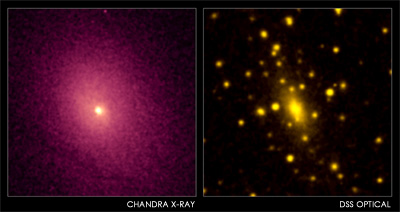Dark Halo

Credit: NASA/CXC/UCI/A.Lewis et al. Optical: Pal.Obs. DSS.
A dark halo is the inferred halo of invisible material (dark matter) that permeates and surrounds individual galaxies, as well as groups and clusters of galaxies.
Evidence for the existence of dark matter first came from studies of the motions of stars and gas in galaxies. For example, the quantity and distribution of luminous matter within disk galaxies cannot account for the rotation curves observed, implying a significant invisible component. In a similar manner, velocity dispersions measured in the outer regions of elliptical galaxies are higher than expected given the luminous matter within the galaxy. Estimates based on these considerations suggest that perhaps as much as 90% of the matter present in galaxies is in the form of dark matter.
Evidence for dark matter is also found through observations of the motions of galaxies in groups and clusters. Using a similar argument to that applied to stellar motions within galaxies, the velocities of galaxies in groups and clusters are so high that the group or cluster would fly apart if only the luminous matter were present.
In addition, the X-ray emitting gas often found throughout galaxy clusters indicates that these clusters must contain large amounts of dark matter. With a temperature in excess of a million degrees, this gas would evaporate from the cluster if the visible elements were the only components.
In both galaxies and groups and clusters of galaxies, the dark matter is found to be distributed in a roughly spherical halo around the visible component – the dark halo. In the Milky Way the dark halo appears to extend out to at least 300,000 light years, and possibly even further, reaching far beyond the extent of the visible matter in the disk.
Study Astronomy Online at Swinburne University
All material is © Swinburne University of Technology except where indicated.

